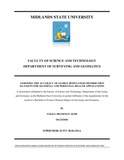Please use this identifier to cite or link to this item:
https://cris.library.msu.ac.zw//handle/11408/2311Full metadata record
| DC Field | Value | Language |
|---|---|---|
| dc.contributor.author | Dube, Yolisa Prudence | - |
| dc.date.accessioned | 2017-06-29T10:45:51Z | - |
| dc.date.available | 2017-06-29T10:45:51Z | - |
| dc.date.issued | 2016 | - |
| dc.identifier.uri | http://hdl.handle.net/11408/2311 | - |
| dc.description.abstract | Global population distribution datasets have been used in a lot of studies and research programmes including public health research due to their availability and large scale geographical coverage. Their increasing application in maternal and perinatal studies has increased the implications of the data extracted from the datasets. The newly developed SDGs with very high expectations in terms of deliverables in the health care sector require high quality data which reveals the heterogeneity existing at subnational levels. These datasets as sources of data therefore need to be cross validated at sub-national levels to quantify the accuracy of the datasets. This study examined the utility of demographic mapping methods and how they have been used to address accuracy issues. It further cross validated WorldPop’s estimates of pregnancies and live births using data (pregnancies and live births outcomes) that was collected as part of a project that was conducted in the regions of Maputo and Gaza provinces in Mozambique as the baseline data as the case study. The WorldPop dataset is one gridded global dataset that maps the population and demographic distributions of low income regions. Statistical analysis was used to determine the errors and performance of the WorldPop model and magnitude of errors at different administrative levels. Overall the results of this study showed that the Worldpop’s pregnancies and live births datasets cannot yet be used without adjustments for the regions of Maputo and Gaza and there is need to improve the population allocation accuracy. Generally, the dataset exhibited a good variation modelling performance especially at higher administrative levels. The review of the demographic mapping methods also revealed better methods that are applicable that could be used in improving the accuracy and detail of global population distribution datasets, the WorldPop dataset included. | en_US |
| dc.subject | Population distribution datasets | en_US |
| dc.title | Assessing the accuracy of global population distribution datasets for maternal and perinatal health applications | en_US |
| item.fulltext | With Fulltext | - |
| item.grantfulltext | open | - |
| Appears in Collections: | Bsc.honours In Surveying And Geomatics | |
Files in This Item:
| File | Description | Size | Format | |
|---|---|---|---|---|
| Dube Pudence.pdf | Full Text | 2.68 MB | Adobe PDF |  View/Open |
Page view(s)
226
checked on Nov 6, 2025
Download(s)
162
checked on Nov 6, 2025
Google ScholarTM
Check
Items in MSUIR are protected by copyright, with all rights reserved, unless otherwise indicated.



